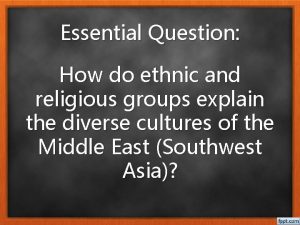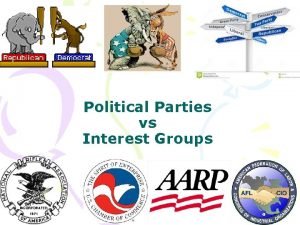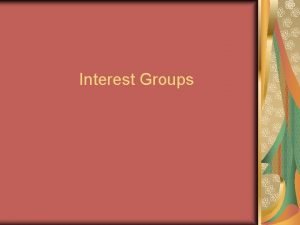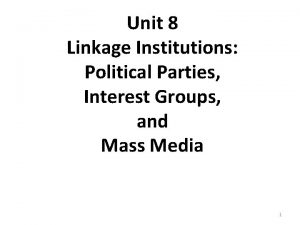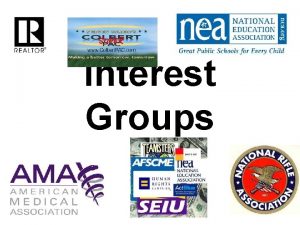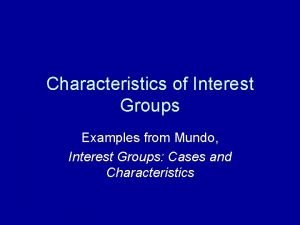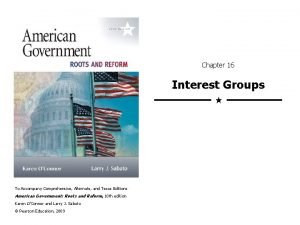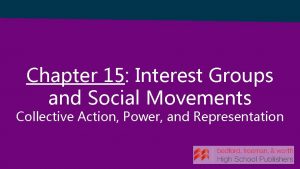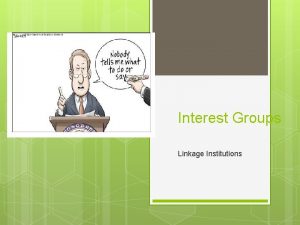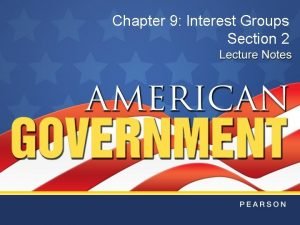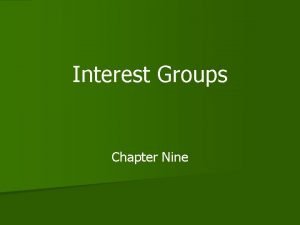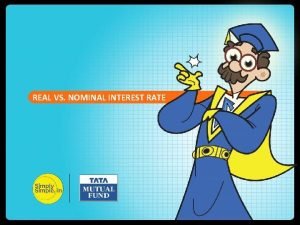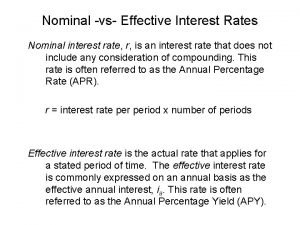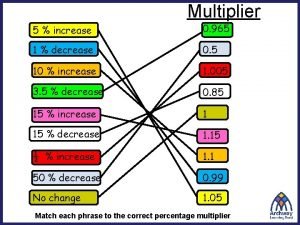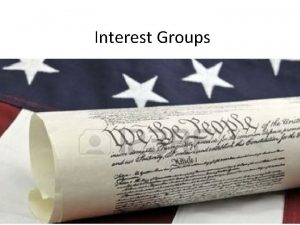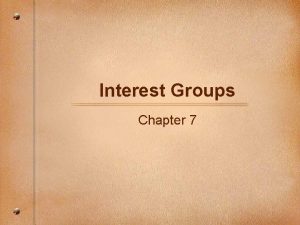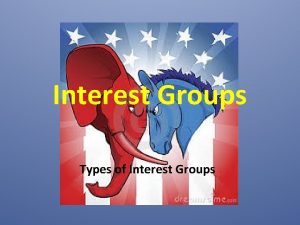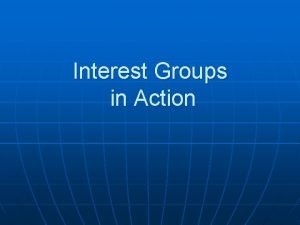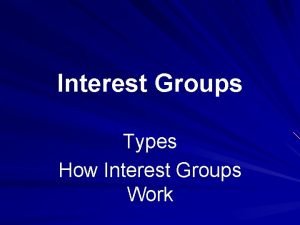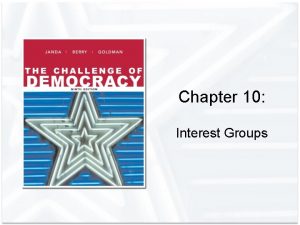INTEREST GROUPS 1 What Are Interest Groups Interest


















- Slides: 18

INTEREST GROUPS 1

What Are Interest Groups? • Interest Group (special interests) is an organization of people with similar policy goals that tries to influence the political process to try to achieve those goals. • Interest groups try to influence every branch and every level of government. • Links citizens to government 2

How are Interest Groups different from Political Parties? • Interest Groups seek support for issues that affect their members (not election to office) • Interest Groups support public officials who support the groups issue • Interest Groups focus on a particular issue • Interest Groups are private organizations accountable only to their members 3

The Roots and Development of American Interest Groups • Interest groups have existed since the country’s founding. – Federalist #10 • The open nature of the American government invites organized political participation. • Labor unions were some of the earliest and best organized interest groups. 4

The Rise of the Interest Group State (1960 s and 1970 s) • Economic Interest Groups – Professional Associations – Trade Associations – Organized Labor • • • Government Interest Groups Civil Rights Ideological Groups Religious Groups Public Interest Groups – “Think Tanks” – Public-Interest Law Firms – Environmental Groups • Single-Issue Groups 6

In pairs… • For each type of interest group, provide a real-life, current example. • Focus on those you would consider joining. • Use a note card to record your examples. 8

What Do Interest Groups Do? • Goals: – Gain access to policy makers – Influence public policy – Support sympathetic policy makers 9

Interest Groups Techniques Direct Techniques: • Lobbying – Private meetings – Testifying – Drafting Legislation – Social Occasions – Providing Political Info – Supplying Nomination suggestions – Contributions (PACs) Indirect Techniques: • Generating Public Pressure – Groundswell of public pressure – Use Constituents as Lobbyists – Building Alliances with other groups 10

Lobbying • Most common and effective technique to influence policymaking • Lobbying… -Congress (about 30, 000 /spend about $2 billion/year) -Executive Branch (regulatory agencies) -Courts (bring cases to the courts, file briefs, influence nominations) • The best lobbyists are truthful and genuine 11

What Makes an Interest Group Successful? • • 1. Leaders – having a prominent leader aids in the reputation of the group and enhances a group's ability to attain its goals. 2. Financial Resources – funding is critical. Without money, it is hard to get your message out. 3. Size – a group must have members to be successful. Organizing members allows for strength in numbers and pooling of financial support. 4. Intensity – the more committed the members the better 13

14

15

16

Hyperpluralist Theory § Detriments of too many groups: § Groups dominate the political decision-making § Consideration of the greater public interest becomes impossible § Policy can become confusing or contradictory § Lawmakers avoid making tough decisions 18

In pairs… • Generate a list of pros and cons for the influence of interest groups. Include at least 3 of each. • In the end, answer these two questions: • 1. Do interest groups represent a net benefit to American society? Why or why not? • 2. What can be done to limit the negative consequences of interest groups? 19

Power Elite Theory • Small number of super rich individuals, powerful corporate interests, & large financial institutions dominate key political areas – PACs develop close connection between money and politics 20

Criticism Interest Groups have been criticized for – Ignoring the wider interest of society – Producing confusion and deadlock in Congress – Generating so much emotion that they make reasoned discussion difficult – Having too much influence 21

Important Points to Think About Interest Groups • Promote interest in public affairs • Provide useful information • Serve as watchdogs • Represent the interest of Citizens 22
 Antigentest åre
Antigentest åre How are ethnic groups and religious groups related
How are ethnic groups and religious groups related Fundamental goal of interest groups
Fundamental goal of interest groups What are interest groups
What are interest groups Proliferation of interest groups
Proliferation of interest groups Definition of linkage institutions
Definition of linkage institutions Chapter 9 section 3 interest groups at work
Chapter 9 section 3 interest groups at work State two characteristics of interest groups
State two characteristics of interest groups Linkage institutions
Linkage institutions A virtue of interest groups is that
A virtue of interest groups is that Interest groups vs social movements
Interest groups vs social movements Free rider problem interest groups
Free rider problem interest groups Federalist 10 interest groups
Federalist 10 interest groups Linkage institutions examples
Linkage institutions examples Chapter 9 section 2 types of interest groups
Chapter 9 section 2 types of interest groups The nature of interest groups
The nature of interest groups What is real interest rate and nominal interest rate
What is real interest rate and nominal interest rate Effective versus nominal interest rates
Effective versus nominal interest rates Simple interest
Simple interest

